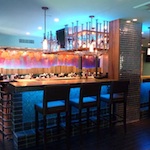I have two degrees, one in civil engineering and one in interior design. I studied civil engineering first, at Westchester Community College, then went on to study interior design at the Fashion Institute of Technology. I was interested in architecture school, but I’d heard that it took five years, and I didn’t want to spend five more years in school because I was paying for it myself, working full time while I studied. It was difficult; I also thought there was probably more work in interiors.
Mark Pavlick: Career Highlights
1979: Enrolls at Westchester Community College and begins working part time as a draftsman in the real estate and construction department at IBM
1982: Graduates from Westchester and begins working full time as a draftsman at Melville Corporation
1983: Enrolls at the Fashion Institute of Technology (FIT)
1984: Begins working at Planned Expansion Group as a project manager
1985: Graduates from FIT
1986–1991: Accepts positions as a project manager at Begg & Daigle, Liz Claiborne, then Brooks Fashion Stores
1992: Visits his first construction site and decides to work in construction
1993: Accepts a position at Supercuts as a construction manager
1996: Accepts a position at Armani Exchange as a project manager
2008: Gets promoted to senior director of construction at Armani Exchange
2010: Installs the first LED lights in an Armani Exchange store
I’ve always worked in real estate and construction. While I was pursuing my civil engineering degree, I worked part time in the real estate and construction division at IBM. Then, when I studied interior design, I worked full time for a company called Melville Corporation, which was the parent company for Chess King, KB Toys, Thom McCann, and a number of other retail stores that are gone now. I was on the boards, which means I was drafting store interiors. That was my entry into retail construction.
I didn’t deliberately choose the business. Back in the 1980s, it was difficult to get a job. Coming out of college, I took what was available, and retailers were hiring draftsmen for store interiors. I worked for a few companies: Liz Claiborne, Brooks Fashion Stores, Supercuts.
A light bulb went off, and I knew I wanted to do construction. As a draftsman, I was drawing on a piece of paper, but I didn’t know how my drawings affected the contractor out in the field. Then, when I was with Brooks Fashion Stores, when I was in charge of all the draftsmen, my boss took me out to one of the stores so I could see what it looked like. That was the first time anyone had done that for me. When I went to the store and saw what it looked like when it was being built and when it was finished, I thought, “This is perfect.” I had drawing talent, but I could relate it to the guys in the field. That’s unusual; there’s usually a disconnect in construction departments between architects, who are always drawing, and contractors, who are always in the field. I’m the link between the two for smooth communication and coordination.
A headhunter alerted me to the position at Armani Exchange. I was surprised. It’s quite a high-end company. The other retailers I’d worked for weren’t, with the exception of Liz Claiborne, but I met the people, they liked me, I liked them. I’ve been here for 16 years now, and it’s been great. Every store I’ve been assigned in the past 16 years has opened on time and on budget.
I do a combination of desk work and site work. Leasing hands me the construction portion of the lease to review and comment on. Once the lease is signed, I take the architect and designer to the property to do a site survey. They develop some sketches, and I take [the project] through construction documents and permitting to bidding the documents with general contractors and vendors to building the store. I also make the first purchase at every store I open. If the cash register is working and everything’s a go, it’s another successful opening.
Working here presents many opportunities. I’m allowed to turn the department the way I want to run it. Lately I’ve been looking at being more green. The company didn’t make an explicit decision to move toward sustainable construction; I gave them the light they liked, and it was energy-efficient. So now we’re transitioning to LED lights in all of our stores. It saves on energy and relamping costs. ABQ


